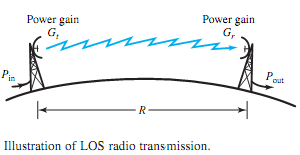Q. Radiation intensity pattern of Antennas?
Antennas do not radiate power equally in all directions in space. The radiation intensity pattern describes the power intensity (which is power per unit solid angle, expressed in units of watts per steradian) in any spatial direction. Conceptually it is convenient to define an isotropic antenna as a lossless antenna that radiates its power uniformly in all directions. Although an isotropic antenna cannot be realized in practice, it serves as a reference for comparison with real antennas. The radiation intensity for such an antenna, with input power P, is a constant in any direction, given by P/4π. The power gain G of a realistic antenna is a measure of the maximum radiation intensity of the antenna as comparedwith the intensity thatwould result froman isotropic antenna, with the same power input. G is then expressed as

Referring to Figure when a power Pt /Lt is applied to the transmitting antenna, let us find the signal power Sr available to the receiver from the receiving antenna. An isotropic transmitting antenna would cause a radiation power density (power per unit area of a sphere) of

For a practical antenna that has power gainGt and loss Lta relative to an isotropic antenna, Equation (15.1.19) would be modified as

We shall assume that the transmitting and receiving antennas (reciprocal elements) point directly toward each other, so that their gains are maximum. Letting Lch denote any losses incurred by the wave in the channel (medium), and Are be the effective area of the receiving antenna, the power that the receiving antenna is able to produce is given by

Accounting for the receiving antenna loss and receiving-path losses, a total system loss L can be defined as

Quite often, for simplicity, in the case of LOS radio transmission illustrated in Figure, the transmission loss for a path of length R is given by

